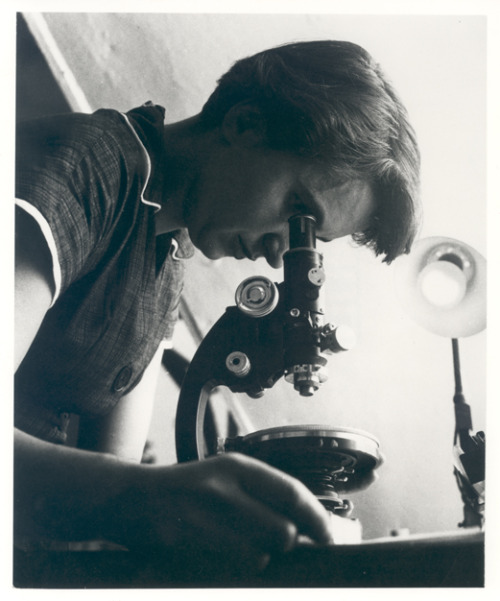DISCOVERY OF CHEMICAL STRUCTURE OF DNA – FEBRUARY 28, 1953

DNA is found mostly in the cell nucleus, but another type of nucleic acid, RNA, is common in the cytoplasm. Watson and Crick proposed that RNA must copy the DNA message in the nucleus and carry it out to the cytoplasm, where proteins are synthesized. Crick also predicted the existence of an “adaptor” molecule that reads the genetic code and selects the appropriate amino acids to add to a growing polypeptide chain. This proposed flow of genetic information from DNA to RNA to protein became known as the “Central Dogma.”
As it turned out, several types of RNA are involved in the utilization of genetic information. In the nucleus, the DNA code is “transcribed,” or copied, into a messenger RNA (mRNA) molecule. In the cytoplasm, the mRNA code is “translated” into amino acids. Translation is orchestrated at the ribosome — itself partly composed of RNA — with transfer RNA playing the role of adaptor.


On this day, February 28, 1953, James Watson and Frances Crick announced their discovery of chemical structure of DNA. It is important to recognize DNA molecules as source of biological information, genetic information, or innate knowledge that enables living cells to perform a variety of guided, sequential, purposeful, and goal-oriented ‘immanent’ actions. It helps me to define term ‘Life’ as, “Life is Knowledge in Action.”

However, DNA molecules do not acquire energy from an external source. Cytoplasm or Protoplasm has power called ‘Nutrition’ with which it attracts matter found in external environment of cell. For this reason, Viruses that are basically constituted by DNA or RNA molecules are not capable of independent existence and their living functions such as replication demand assistance from a living host cell.

DNA is an important biomolecule for it directs protein synthesis and yet it does not qualify as the vital, animating principle found in all living organisms.
Animal cells contain three main regions: plasma membrane, nucleus, and cytoplasm. The nucleus is a cell’s central organelle, which contains the cell’s DNA. The cytoplasm is composed of two parts, the cytosol and organelles. Cytosol, the jelly-like substance within the cell, provides the fluid medium necessary for biochemical reactions. An organelle (“little organ”) is one of several different types of membrane-enclosed bodies in the cell, each performing a unique function. Just as the various bodily organs work together in harmony to perform all of a human’s functions, the many different cellular organelles work together to keep the cell healthy and performing all of its important functions.
In my analysis, I use the term ‘Spiritual’ to describe the harmonious interactions between the plasma membrane, nucleus, cytoplasm, and the various intracellular organelles in the performance of various living functions. These harmonious interactions are possible on account of the ‘Spiritual’ Nature of the Corporeal Substance or the Living Matter called Protoplasm or Cytoplasm.
Rudra Narasimham Rebbapragada
Ann Arbor, MI 48104-4162 USA
BHAVANAJAGAT. ORG
Feb 28
THIS DAY IN HISTORY

This Day In History: 02/28/1953 – DNA Structure Discovered
On February 28th many historical events occurred. These events are recapped by Russell Mitchell in this video clip from “This Day in History”. The discovery of DNA by James Watson and Frances Crick being a major one for the scientific community. Not only was DNA discovered on this day, but the Republican Party was founded in Wisconsin. The well-known album Thriller by Michael Jackson won eight Emmy awards as well.
1953
Watson and Crick discover chemical structure of DNA
On this day in 1953, Cambridge University scientists James D. Watson and Frances H.C. Crick announce that they have determined the double-helix structure of DNA, the molecule containing human genes.
Though DNA–short for deoxyribonucleic acid–was discovered in 1869, its crucial role in determining genetic inheritance wasn’t demonstrated until 1943. In the early 1950s, Watson and Crick were only two of many scientists working on figuring out the structure of DNA. California chemist Linus Pauling suggested an incorrect model at the beginning of 1953, prompting Watson and Crick to try and beat Pauling at his own game. On the morning of February 28, they determined that the structure of DNA was a double-helix polymer, or a spiral of two DNA strands, each containing a long chain of monomer nucleotides, wound around each other. According to their findings, DNA replicated itself by separating into individual strands, each of which became the template for a new double helix. In his best-selling book, The Double Helix (1968), Watson later claimed that Crick announced the discovery by walking into the nearby Eagle Pub and blurting out that “we had found the secret of life.” The truth wasn’t that far off, as Watson and Crick had solved a fundamental mystery of science–how it was possible for genetic instructions to be held inside organisms and passed from generation to generation.
Watson and Crick’s solution was formally announced on April 25, 1953, following its publication in that month’s issue of Nature magazine. The article revolutionized the study of biology and medicine. Among the developments that followed directly from it were pre-natal screening for disease genes; genetically engineered foods; the ability to identify human remains; the rational design of treatments for diseases such as AIDS; and the accurate testing of physical evidence in order to convict or exonerate criminals.
Crick and Watson later had a falling-out over Watson’s book, which Crick felt misrepresented their collaboration and betrayed their friendship. A larger controversy arose over the use Watson and Crick made of research done by another DNA researcher, Rosalind Franklin, whose colleague Maurice Wilkins showed her X-ray photographic work to Watson just before he and Crick made their famous discovery. When Crick and Watson won the Nobel Prize in 1962, they shared it with Wilkins. Franklin, who died in 1958 of ovarian cancer and was thus ineligible for the award, never learned of the role her photos played in the historic scientific breakthrough.
© 2016, A&E Television Networks, LLC. All Rights Reserved.





